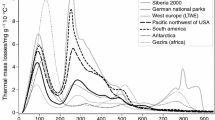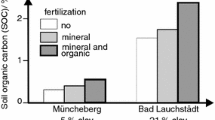Abstract
Purpose
This exploratory study evaluates the potential of nanothermal analysis (nTA) coupled with atomic force microscopy (AFM) of soil samples for understanding physicochemical processes in soil and for linking the nanospatial and microspatial distribution of thermal characteristics with the macroscopic properties of soil samples.
Materials and methods
Soil and reference samples were investigated by differential scanning calorimetry and AFM-nTA. nTA was conducted on 16 points of each AFM image in two subsequent heating cycles (55–120°C and 55–300°C, respectively). Thermograms were subdivided into characteristic types and their spatial distribution was compared between sample replicates and materials.
Results and discussion
Thermogram types consisted of partly structured expansion and compression phases, suggesting material-specific thermal profiles. The distribution of thermogram types reflected sample-dependent nanoscale and microscale heterogeneity. Indications for water molecule bridge transitions were found by nTA in peat and soil. Organic materials generally revealed strong expansion and irreversible compression phases, latter probably due to the collapse of pore and aggregate structures. In contrast to charcoal and manure, peat shows strong expansion below 120°C and compression only above 120°C.
Conclusions
All investigated samples are heterogeneous on the nanoscale and microscale with respect to thermal behaviour. AFM-nTA allows distinguishing numerous different materials on nanometre and micrometre scales in soil samples. The material-dependent characteristics will help in understanding and learning more about the nanoscale distribution of different materials and properties. Related to the macroscopic thermal behaviour, this will allow studying links between the properties of biogeochemical interfaces and the processes governed by them.







Similar content being viewed by others
Abbreviations
- AFM:
-
Atomic force microscopy
- AFM-nTA:
-
Atomic force microscopy coupled with nanothermal analysis
- α :
-
Apparent expansion coefficient
- DSC:
-
Differential scanning calorimetry
- EDX:
-
Energy-dispersive X-ray spectroscope (respective spectroscopy)
- ESEM:
-
Environmental scanning electron microscope (respective microscopy)
- κ :
-
Apparent compression coefficient
- L-TMA:
-
Localized thermomechanical analysis
- NMR:
-
Nuclear magnetic resonance
- nTA:
-
Nanothermal analysis
- ROI:
-
Region of interest
- SOM:
-
Soil organic matter
- TGA:
-
Thermogravimetric analysis
- T g :
-
Glass transition temperature
- T*:
-
WaMB transition temperature
- TMA:
-
Thermomechanical analysis
- WaMB:
-
Water molecule bridge
References
Aquino A, Tunega D, Pasalić H, Schaumann GE, Haberhauer G, Gerzabek MH, Lischka H (2011) Molecular dynamics simulations of water molecule-bridges in polar domains of humic acids. Environ Sci Technol 45(19):8411–8419
Aquino AJA, Tunega D, Schaumann GE, Haberhauer G, Gerzabek MH, Lischka H (2009) Stabilizing capacity of water bridges in nanopore segments of humic substances: a theoretical investigation. J Phys Chem C 113:16468–16475
Bikiaris DN, Karayannidis GP (1996) Thermomechanical analysis of chain-extended PET and PBT. J Appl Polym Sci 60(1):55–61
Chiou CH, Chang SJ, Lee GB, Lee HH (2006) New fabrication process for monolithic probes with entegrated heaters for nanothermal machining. Jpnn J Appl Phy Part 1—Regular Papers Brief Communications & Review Papers 45(1):208–214
Dai X, Reading M, Craig DQM (2009) Mapping amorphous material on a partially crystalline surface: nanothermal analysis for simultaneous characterisation and imaging of lactose compacts. J Pharm Sci 98(4):1499–1510
DeLapp RC, LeBoeuf EJ (2004) Thermal analysis of whole soils and sediment. J Environ Qual 33(1):330–337
Dell'Abate MT, Benedetti A, Brookes PC (2003) Hyphenated techniques of thermal analysis for characterisation of soil humic substances. J Sep Sci 26(5):433–440
Dell'Abate MT, Benedetti A, Sequi P (2000) Thermal methods of organic matter maturation monitoring during a composting process. J Therm Anal Calorim 61(2):389–396
Frost RL, Ding Z (2003) Controlled rate thermal analysis and differential scanning calorimetry of sepiolites and palygorskites. Thermochimica Acta 397(1–2):119–128
Grim RE, Rowland RA (1942a) Differential thermal analysis of clay minerals and other hydrous materials. Part 1. Ceram Abstracts 27:746–761
Grim RE, Rowland RA (1942b) Differential thermal analysis of clay minerals and other hydrous materials. Part 2. Ceram Abstracts 27:801–818
Hu W-G, Mao J, Xing B, Schmidt-Rohr K (2000) Poly(methylene) crystallites in humic substances detected by nuclear magnetic resonance. Environ Sci Technol 34:530–534
Hammiche A, Reading M, Pollock HM, Song M, Hourston DJ (1996) Localized thermal analysis using a miniaturized resistive probe. Rev Sci Instrum 67(12):4268–4274
Harding L, King WP, Dai X, Craig DQM, Reading M (2007) Nanoscale characterisation and imaging of partially amorphous materials using local thermomechanical analysis and heated tip AFM. Pharm Res 24(11):2048–2054
Henderson JB, Emmerich WD (1991) Polymer characterization using thermomechanical analysis. J Therm Anal 37(8):1825–1831
Höhne GWH, Hemminger W, Flammersheim H-J (1996) Differential scanning calorimetry. An introduction for practitioners. Springer, Berlin
Hurraß J, Schaumann GE (2007) Influence of the sample history and the moisture status on the thermal behavior of soil organic matter. Geochim Cosmochim Acta 71:691–702
Hurrass J, Schaumann GE (2005) Is glassiness a common characteristic of soil organic matter? Environ Sci Technol 39(24):9534–9540
Jaeger A, Schaumann GE, Bertmer M (2011) Optimized NMR spectroscopic strategy to characterize water dynamics in soil samples. Org Geochem 42(8):917–925
Jaeger F, Shchegolikhina A, van As H, Schaumann GE (2010) Proton NMR relaxometry as a useful tol to evaluate swelling processes in peat soils. The Open Magnetic Resonance Journal 3:27–45
Keinath SE, Boyer RF (1981) Thermomechanical analysis of T g and T > T g transitions in polystyrene. J Appl Polym Sci 26(6):2077–2085
King WP, Saxena S, Nelson BA, Weeks BL, Pitchimani R (2006) Nanoscale thermal analysis of an energetic material. Nano Lett 6(9):2145–2149
Kögel-Knabner I, Ding G-C, Heister K, Pronk GJ, Schaumann GE, Schloter M, Schulz S, Schwarz J, Smalla K (2010) Formation of biogeochemical interfaces in soils as controlled by mineral and organic components. 19th World Congress of Soil Science (WCSS) Brisbane, 1–6 August 2010, pp 74–77
Kucerik J, Kislinger J, Majzlik P, Pekar M (2009) Correlation of humic substances chemical properties and their thermo-oxidative degradation kinetics. J Therm Anal Calorim 98(1):207–214
Larsen JW (1988) Macromolecular structure and coal pyrolysis. Fuel Process Technol 20:13–22
LeBoeuf EJ, Weber WJ (2000) Macromolecular characteristics of natural organic matter. 1. Insights from glass transition and enthalpic relaxation behavior. Environ Sci Technol 34(17):3623–3631
Lee BJ, Chen YB, Zhang ZM (2008) Confinement of infrared radiation to nanometer scales through metallic slit arrays. J Quant Spectrosc Ra 109(4):608–619
Leinweber P, Schulten HR, Horte C (1992) Differential thermal-analysis, thermogravimetry and pyrolysis field-ionization mass-spectrometry of soil organic-matter in particle-size fractions and bulk soil samples. Thermochimica Acta 194:175–187
Lucht LM, Larson JM, Peppas NA (1987) Macromolecular structure of coals. 9. Molecular structure and glass transition temperature. Energ Fuel 1:56–58
Mikutta R, Schaumann GE, Gildemeister D, Bonneville S, Kramer MG, Chorovere J, Chadwick OA, Guggenberger G (2009) Biogeochemistry of mineral–organic associations across a long-term mineralogical soil gradient (0.3–4100 kyr), Hawaiian Islands. Geochimica Et Cosmochimica Acta 73(7):2034–2060
Nelson BA, King WP (2007) Measuring material softening with nanoscale spatial resolution using heated silicon probes. Rev Sci Instrum 78(2):023702
Ng TH, Williams HL (1981) Thermomechanical analysis of linear aromatic polyesters. Makromolekulare Chemie 182(11):3323–3330
O'Neal HR, Welch S, Rogers J, Guilford S, Curran G, Menard KP (1995) Comparison of T g values for a graphite epoxy composite by differential scanning calorimetry (DSC), thermomechanical analysis (TMA), and dynamic mechanical analysis (DMA). J Adv Mater 26(3):49–54
Plante AF, Fernández JM, Leifeld J (2009) Application of thermal analysis techniques in soil science. Geoderma 153(1–2):1–10
Provenzano MR, Ouatmane A, Hafidi M, Senesi N (2000) Differential scanning calorimetric analysis of composted materials from different sources. J Therm Anal Calorim 61(2):607–614
Schaumann GE (2005) Matrix relaxation and change of water state during hydration of peat. Colloid Surface A 265(1–3):163–170
Schaumann GE, Bertmer M (2008) Do water molecules bridge soil organic matter molecule segments? Eur J Soil Sci 59(3):423–429
Schaumann GE, LeBoeuf EJ (2005) Glass transitions in peat—their relevance and the impact of water. Environ Sci Technol 39(3):800–806
Schaumann GE, LeBoeuf EJ, DeLapp RC, Hurraß J (2005) Thermomechanical analysis of air-dried whole soil samples. Thermochimica Acta 436(1–2):83–89
Schaumann GE, Thiele-Bruhn S (2011) Molecular modelling of soil organic matter: squaring the circle? Geoderma 166(1):1–14
Siewert C (2004) Rapid screening of soil properties using thermogravimetry. Soil Sci Soc Am J 68:1656–1661
Young KD, LeBoeuf EJ (2000) Glass transition behavior in a peat humic acid and an aquatic fulvic acid. Environ Sci Technol 34(21):4549–4553
Zhang J, Bunker M, Parker A, Madden-Smith CE, Patel N, Roberts CJ (2011) The stability of solid dispersions of felodipine in polyvinylpyrrolidone characterized by nanothermal analysis. Int J Pharm 414(1–2):210–217
Zhang JX, Bunker M, Chen XY, Parker AP, Patel N, Roberts CJ (2009) Nanoscale thermal analysis of pharmaceutical solid dispersions. Int J Pharm 380(1–2):170–173
Acknowledgements
This study has been supported by the Deutsche Forschungsgemeinschaft, Project SCHA849/8 within the priority programme SPP 1315 Biogeochemical Interfaces in Soil. We also thank Dr. Jiri Kucerik for assistance in obtaining the ESEM pictures, Dr. Jette Schwarz for the DSC measurements and Ms. Priya Mary Abraham for assistance at AFM measurements and all of them for helpful discussions.
Author information
Authors and Affiliations
Corresponding author
Additional information
Responsible editor: Michael Kersten
An erratum to this article can be found at http://dx.doi.org/10.1007/s11368-011-0459-8
Rights and permissions
About this article
Cite this article
Schaumann, G.E., Kunhi Mouvenchery, Y. Potential of AFM–nanothermal analysis to study the microscale thermal characteristics in soils and natural organic matter (NOM). J Soils Sediments 12, 48–62 (2012). https://doi.org/10.1007/s11368-011-0443-3
Received:
Accepted:
Published:
Issue Date:
DOI: https://doi.org/10.1007/s11368-011-0443-3




